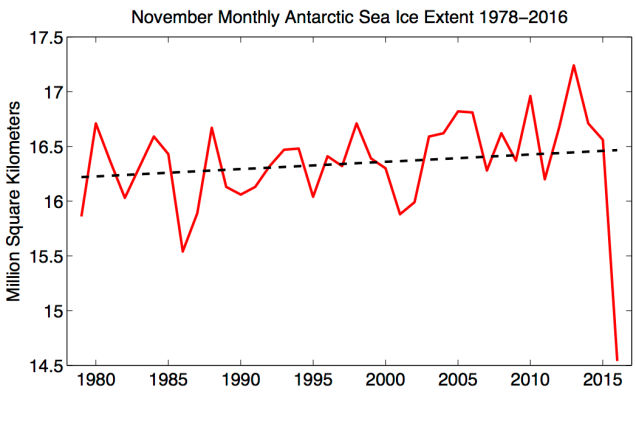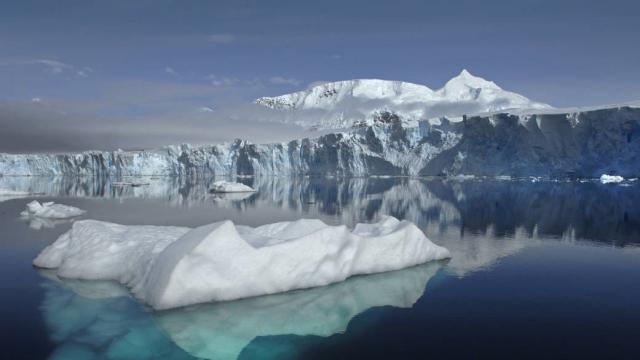The disappearance of Arctic sea ice is a well-documented trend with a well-established cause. But this past summer, Earth scientists were startled to see Antarctic sea ice take a nosedive, too. Now, scientists at the British Antarctic Survey are blaming the event on a spate of freak weather, underscoring how much we still have to learn about what controls ice around the south pole.
Image: British Antarctic Survey
[referenced url=”https://gizmodo.com.au/2017/03/antarctic-sea-ice-crashed-this-year-and-scientists-dont-know-why/” thumb=”https://i.kinja-img.com/gawker-media/image/upload/t_ku-large/f6azpvbxuylelybv6oqw.jpg” title=”Antarctic Sea Ice Crashed This Year And Scientists Don’t Know Why” excerpt=”Just about every month, it seems, we get a report on the dismal state of Arctic sea ice. By contrast, the shiny white stuff surrounding the Antarctic continent has been remarkably stable in a warming world. This year, however, the sea ice at our planet’s south pole is crashing and scientists don’t know why.”]
From September to November of 2016, the ring of ice surrounding Antarctica melted at a rate of up to 75,000km2 per day, faster than any other springtime melt since satellite record-keeping began. By March 1, the peak of the austral summer, Antarctic sea ice had shrunk to 2.1 million km2, an all-time low. Typically, Antarctic sea ice bottoms out at about 3 million km2, or 30 per cent more ice.
If you need visual proof that this summer was really weird, just take a look at this graph of the average Antarctic sea ice extent for the month of November:

This summer’s sudden, dramatic melt had scientists scratching their heads for months. Now, after carefully comparing sea ice trend data with atmospheric circulation patterns, a team of researchers is offering a likely explanation. Writing in Geophysical Research Letters last month, the scientists explain how the sea ice crash coincided with a series of remarkable weather anomalies and storms — beginning, in September, with an extreme low pressure centre in the Amundsen sea off the coast of West Antarctica. In October, strong atmospheric Rossby waves brought additional heat toward the south pole, triggering ice loss in the Ross Sea and Indian Ocean. By November, the Weddell Sea was shedding 77,700km2 of ice — roughly the area of South Carolina — each day.
“There’s no indication this is anything but just natural variability,” lead study author John Turner said in a statement. “It highlights the fact that the climate of the Antarctic is incredibly variable.”
Cecilia Bitz, a sea ice researcher at the University of Washington, told Gizmodo that the explanation offered in the new paper “sounds accurate” and matches well with her own interpretation of the sea ice data. Bitz and her postdoc currently have a paper under review, which she described as “entirely complementary and in agreement” with Turner’s.

Sea ice concentrations in the Southern Ocean around Antarctica, data accessed July 2nd 2017. Image: National Snow and Ice Data Center
Explaining weather patterns and climate trends over our planet’s southernmost continent is proving to be an incredible challenge. 2016 aside, Antarctic sea ice has been slowly but steadily expanding over the satellite record, reaching an all-time high in October of 2014, in spite of the global warming trend. Scientists have attributed this seemingly bizarre expansion to everything from topography to decadal climate patterns to the ozone hole to global warming itself — but the truth is we still aren’t entirely sure what’s going on.
The insights of the new study are useful because they add another layer to our understanding of the variability in ice around the south pole. They’re made stronger by the fact that other researchers are already replicating them, but more minds and more data could cause the picture to evolve even further. The hope is that the steady accumulation of scientific knowledge will help us better predict Antarctica’s future — and help humanity prepare for the consequences.
